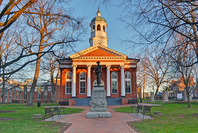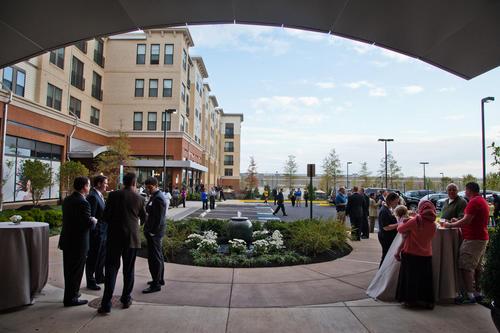Can Loudoun grow while protecting its rural areas?

The Loudoun County courthouse in Leesburg. Photo by lokeswari on Flickr.
For years, Loudoun County was one of the nation’s fastest growing counties and an instructive example of the downsides of sprawl. Meanwhile, it’s a nationally recognized center for horse breeding and for its wineries. How can the county manage ongoing growth without losing its rural areas?
Running north-south from Point of Rocks to Aldie, US 15 bisects the county into developed and rural halves. Loudoun’s eastern half is a rapidly developing area that made it the nation’s wealthiest county and one of its fastest growing counties.
This area contains Dulles Airport, a large number of technology businesses, and increasing racial and socioeconomic diversity. Soon, Metro’s Silver Line will extend to Loudoun County, taking workers to job centers like Reston and Tysons Corner.
In Loudoun’s western half, small towns and villages like Purcellville and Waterford dot the landscape among miles of rolling countryside. However, extreme development pressures put this land essential to the agricultural economy at risk.
How can the county continue to grow in a more sustainable manner and reverse existing planning mistakes? This two-part series will look at what Loudoun General Plan recommends for the county’s Suburban Policy Area, or SPA, in the east and the Rural Policy Area, or RPA, in the west.
Both halves of Loudoun face unique challenges and risks, but they must play to their strengths. Each half has a specific role to play in the county, but they can complement one another. Despite tension between the two areas, Loudoun’s success stems from being able to successfully plan and manage both suburban and rural places.
Where growth is happening

Brambleton, one of many new planned communities in Loudoun County’s eastern half. Photo by Dan Reed on Flickr.
The Suburban Policy Area (PDF) is predicted to absorb seventy five percent of all of Loudoun’s growth in the near future. By 2020, the SPA will have a population density of about 2200 people per square mile, which is close to Fairfax’s current county-wide density of around 2300 people per square mile.
Sprawl has blurred many of the borders between Loudoun neighborhoods. Shopping centers blend together and there’s a distinct lack of a center in many of the communities. Recognizing this, the SPA plan recommends creating four distinct “towns” in the county’s eastern half: Ashburn, Sterling, Potomac and Dulles.
The towns would be compact and have a mix of uses, allowing them to have distinct centers and a strong sense of community identity. Schools and community centers would go in places where they can be easily reached by foot or bicycle. A greenbelt would wrap around each town, providing physical separation between communities and creating a network of open space and trails. The county could use Transfers of Development Rights, or TDRs, to allow greater density at other sites to preserve the open spaces.
For decades, Loudoun has planned only for cars while ignoring all other transportation modes. It will be relatively easy to add “complete streets” to new developments, but it will take a lot of work to make current roads safer and more attractive for walking and biking, especially ones like Route 7 that are over 100 feet wide and have grade-separated interchanges.
Where is the transit?
These are all good ideas, but in order to make them happen, Loudoun will have to find a way to deal with both existing and future traffic congestion. This must include more comprehensive intra-county transit.
The county’s general plan devotes a lot of space to widening roads and adding interchanges. However, there’s hardly any mention of any sort of public transportation, outside of vague references to future Silver Line stations and the desire to build transit-oriented developments around them.
Right now, Loudoun County Transit runs commuter buses from park and ride lots in the county to downtown DC or Metro stations elsewhere in Northern Virginia. Virginia Regional Transit operates shuttles between neighborhoods and shopping centers, but only every forty-five minutes. Transfers between lines are few and far between.
Now that the county is committed to building the Silver Line, it must create a true transit network that not only connects communities to Metro but to each other. This would relieve congestion on many of Loudoun’s roads and head off the desire to continually widen arterial roads. Loudoun needs transit sooner rather than later to handle what’s already here and for future infill development.
Make it denser and give Loudoun an identity
Many people would say that what Loudoun needs to do is stop growing. That wouldn’t help the county improve its communities or its traffic.
The county is urbanizing rapidly and must be able to pay for the costs of new services that more citizens require. Loudoun already has higher property taxes than Fairfax or Arlington, and the improvements to the transportation network will need to rely on carefully planned growth to maximize the county’s investment. In order for Loudoun to hold on to its agricultural heritage, it must ensure that its developed areas are planned with excellence.
In part two, we’ll talk about the Rural Policy Area.


